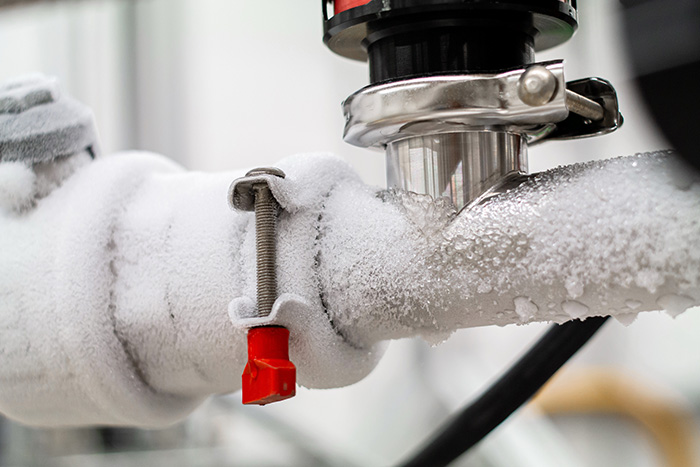What are your opinions about Winter Plumbing Precautions: Preventing Frozen Pipes?

Winter can wreak havoc on your plumbing, particularly by freezing pipes. Here's how to avoid it from occurring and what to do if it does.
Introduction
As temperatures decrease, the threat of icy pipelines rises, possibly bring about pricey fixings and water damages. Understanding just how to stop frozen pipelines is vital for property owners in cool environments.
Comprehending Icy Pipes
What creates pipelines to ice up?
Pipelines ice up when subjected to temperatures below 32 ° F (0 ° C) for extended durations. As water inside the pipes freezes, it broadens, putting pressure on the pipe wall surfaces and potentially causing them to burst.
Threats and problems
Frozen pipelines can bring about supply of water disruptions, home damage, and expensive fixings. Burst pipes can flooding homes and trigger substantial architectural damages.
Indicators of Frozen Pipeline
Identifying frozen pipelines early can stop them from bursting.
Just how to recognize icy pipes
Look for decreased water circulation from taps, uncommon smells or sounds from pipelines, and noticeable frost on revealed pipelines.
Avoidance Tips
Protecting vulnerable pipes
Wrap pipelines in insulation sleeves or utilize warm tape to safeguard them from freezing temperatures. Concentrate on pipelines in unheated or exterior areas of the home.
Home heating methods
Maintain indoor areas effectively heated, specifically locations with pipes. Open up cabinet doors to enable warm air to distribute around pipelines under sinks.
Securing Outdoor Pipes
Yard pipes and outdoor faucets
Detach and drain pipes yard tubes before winter. Install frost-proof spigots or cover outdoor taps with shielded caps.
What to Do If Your Pipelines Freeze
Immediate activities to take
If you suspect frozen pipelines, keep faucets open up to relieve pressure as the ice melts. Make use of a hairdryer or towels taken in hot water to thaw pipes slowly.
Long-Term Solutions
Structural modifications
Take into consideration rerouting pipes away from exterior wall surfaces or unheated locations. Add extra insulation to attics, basements, and crawl spaces.
Updating insulation
Purchase high-quality insulation for pipes, attics, and walls. Appropriate insulation helps preserve consistent temperatures and decreases the danger of icy pipelines.
Conclusion
Stopping icy pipelines requires positive steps and quick feedbacks. By recognizing the causes, signs, and safety nets, property owners can shield their pipes throughout winter.
Helpful Tips to Prevent Frozen Pipes this Winter
UNDERSTANDING THE BASICS: WHY PIPES FREEZE AND WHY IT’S A PROBLEM
Water freezing inside pipes is common during the winter months, but understanding why pipes freeze, and the potential problems it can cause is crucial in preventing such incidents. This section will delve into the basics of why pipes freeze and the associated problems that may arise.
THE SCIENCE BEHIND FROZEN PIPES
When water reaches freezing temperatures, it undergoes a physical transformation and solidifies into ice. This expansion of water as it freezes is the primary reason pipes can burst. As the water inside the pipe freezes, it expands, creating immense pressure on the walls. If the pressure becomes too great, the pipe can crack or rupture, leading to leaks and water damage.
FACTORS THAT CONTRIBUTE TO PIPE FREEZING
Low Temperatures: Extremely cold weather, especially below freezing, increases the risk of pipes freezing. Uninsulated or Poorly Insulated Pipes: Pipes located in unheated areas, such as basements, crawl spaces, or attics, are more prone to freezing. Insufficient insulation or lack of insulation altogether exacerbates the problem. Exterior Wall Exposure: Pipes running along exterior walls are susceptible to freezing as they encounter colder temperatures outside. Lack of Heating or Temperature Regulation: Inadequate heating or inconsistent temperature control in your home can contribute to frozen pipes. PROBLEMS CAUSED BY FROZEN PIPES
- Pipe Bursting: As mentioned earlier, the expansion of water as it freezes can cause pipes to burst, resulting in significant water damage.
- Water Damage: When pipes burst, it can lead to flooding and water damage to your property, including walls, ceilings, flooring, and personal belongings.
- Structural Damage: Prolonged exposure to water from burst pipes can compromise the structural integrity of your home, leading to costly repairs.
- Mold and Mildew Growth: Excess moisture from water damage can create a favorable environment for mold and mildew growth, posing health risks to occupants.
- Disrupted Water Supply: Frozen pipes can also result in a complete or partial loss of water supply until the issue is resolved.
WHY CERTAIN PIPES ARE MORE PRONE TO FREEZING
- Location: Pipes located in unheated or poorly insulated areas, such as basements, crawl spaces, attics, or exterior walls, are at higher risk of freezing.
- Exterior Pipes: Outdoor pipes, such as those used for irrigation or exposed plumbing, are particularly vulnerable to freezing as they are directly exposed to the elements.
- Supply Lines: Pipes that carry water from the main water supply into your home, including the main water line, are critical to protect as freezing in these lines can affect your entire plumbing system.
- Underground Pipes: Pipes buried underground, such as those connected to sprinkler systems or outdoor faucets, can be susceptible to freezing if not properly insulated.
https://busybusy.com/blog/helpful-tips-to-prevent-frozen-pipes-this-winter/

Do you appreciate more info about 6 Ways to Prevent Frozen Pipes? Write a short review directly below. We'd be happy to see your insights about this write up. Hoping that you visit us again in the near future. Enjoyed reading our piece of writing? Please quickly share it. Help somebody else locate it. Kudos for your time. Come back soon.
Book Your Service